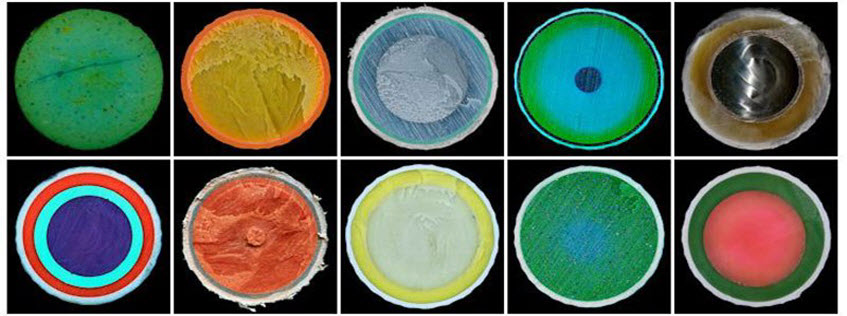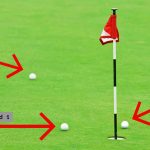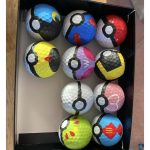Golf balls are made of a core and a cover. The core is usually rubber, and the cover is typically made of urethane or Surlyn.
Golf balls have evolved significantly over the years. Modern golf balls are designed to offer maximum performance, combining distance and control. The core, often made of rubber or a composite material, provides the ball with its initial energy. This is crucial for achieving long distances.
The cover, usually made of urethane or Surlyn, affects the ball’s feel and spin. Golfers can choose balls that match their playing style, whether they prioritize distance, control, or a balance of both. Understanding the materials used in golf balls can help players make better choices and improve their game.
Introduction To Golf Balls
Golf balls are essential for the game of golf. They have evolved over time. Understanding their composition helps players choose the right ball. This can enhance their performance on the course.
Brief History
The first golf balls were made of wood. These balls were used in the 14th century. Later, feather-filled leather balls became popular. These were called “featheries”. The gutta-percha ball appeared in the mid-19th century. It was more durable than featheries. By the early 20th century, rubber-core balls were introduced. These balls offered better performance. They became the standard in golf.
Modern Evolution
Today’s golf balls are made with advanced materials. They have a complex structure. Most modern golf balls have a multi-layer design. This includes a core, mantle, and cover. Each layer serves a specific purpose. The core is usually made of rubber or synthetic materials. It provides the ball’s initial velocity. The mantle layer enhances control and spin. The cover is often made of urethane or Surlyn. It affects the ball’s feel and durability.
Here is a simple table showing the evolution of golf balls:
| Era | Material |
|---|---|
| 14th Century | Wood |
| 17th Century | Feather-filled Leather |
| Mid-19th Century | Gutta-percha |
| Early 20th Century | Rubber-core |
| Modern Day | Multi-layer (Rubber, Urethane, Surlyn) |
Modern golf balls also come in different types. Some are designed for distance. Others focus on control and spin. Here are the main types of modern golf balls:
- Distance Balls: Maximize distance, lower spin.
- Control Balls: Balance between distance and spin.
- Spin Balls: Higher spin, better control around greens.
Choosing the right golf ball can improve your game. Different balls suit different playing styles. Understanding the materials and construction helps you make informed choices.
Core Components
Understanding the core components of a golf ball is crucial. The core determines the ball’s performance, distance, and feel. Different types of cores are used to meet various playing needs. Let’s explore the core components of golf balls.
Solid Core
Most modern golf balls have a solid core. This core is usually made from rubber or synthetic materials. The solid core provides consistency and durability. It helps in achieving longer distances. Golfers who prefer a straightforward feel often choose these balls.
Liquid Core
The liquid core is less common but quite fascinating. It contains a liquid center, usually a mix of water and other chemicals. This type of core provides a unique feel and can enhance spin control. Some golfers prefer liquid cores for their softer feel.
Outer Layers
The outer layer of a golf ball affects its performance. It is crucial in determining the ball’s durability, spin, and control. Understanding these layers can help players choose the best golf balls for their game.
Cover Materials
The cover of a golf ball is usually made from two types of materials: Surlyn and Urethane. Surlyn is a durable material often used in two-piece golf balls. It provides excellent distance and durability. Urethane, on the other hand, is softer and used in three-piece or multi-layer balls. It offers better control and spin around the greens.
Surlyn covers are great for beginners and high-handicap players. They provide more distance and are less expensive. Urethane covers are preferred by advanced players. They provide better feel and control, especially on short shots.
Dimples Design
Dimples on a golf ball are not just for looks. They play a critical role in the ball’s aerodynamics. The number, size, and pattern of dimples affect the ball’s flight. Most golf balls have between 300 to 500 dimples.
Dimples create a thin layer of air around the ball. This layer reduces drag and allows the ball to travel farther. They also help the ball maintain a stable flight path. Different dimple designs can influence how high or low the ball flies.
Here is a quick comparison of dimple designs:
| Dimple Design | Characteristics |
|---|---|
| Shallow Dimples | Higher flight, more carry distance |
| Deep Dimples | Lower flight, more roll distance |
| Hexagonal Dimples | More stable flight, less wind interference |
Choosing the right dimple design can improve your game. It is important to test different designs to see what works best for you.
Types Of Golf Balls
Understanding the types of golf balls can help improve your game. Different golf balls are designed for various levels of players and specific playing conditions. Here, we will explore the main types of golf balls: Two-Piece Balls and Multi-Layer Balls.
Two-piece Balls
Two-piece balls are the most common type of golf balls. They are designed for distance and durability. These balls consist of two layers:
- Core: The core is usually made of solid rubber. It provides a high level of energy transfer, resulting in greater distance.
- Cover: The outer layer is made of a tough material called Surlyn. This cover is durable and offers less spin.
Two-piece balls are ideal for beginners and casual players. They are also budget-friendly and provide excellent value for money.
Multi-layer Balls
Multi-layer balls are designed for more advanced players. They offer better control and feel. These balls have multiple layers, usually three or more:
- Core: The core is often made of softer materials. This allows for better compression and control.
- Mantle: The mantle layer(s) add more control and spin to the ball.
- Cover: The outer layer is typically made of urethane. This cover provides a softer feel and higher spin rates.
Multi-layer balls are suitable for players who want precision and control. They are usually more expensive but offer superior performance.
| Type of Ball | Layers | Core Material | Cover Material | Best For |
|---|---|---|---|---|
| Two-Piece Balls | 2 | Solid Rubber | Surlyn | Beginners, Casual Players |
| Multi-Layer Balls | 3 or more | Softer Materials | Urethane | Advanced Players |
Materials Used
Golf balls are crafted using a variety of materials. These materials contribute to the ball’s performance and durability. Understanding what goes into a golf ball helps players choose the right one.
Rubber
Rubber is one of the primary materials used in golf balls. It is often found in the core of the ball. The core affects the ball’s compression and distance.
Modern golf balls usually have a solid rubber core. This core provides a consistent and reliable performance. Rubber also offers excellent elasticity. This means better energy transfer on impact.
Polyurethane
Polyurethane is another key material in golf balls. It is typically used for the outer cover. This cover affects the ball’s feel and control.
Polyurethane covers are popular among professional golfers. They offer a soft feel and excellent spin control. This material is also very durable. It withstands the wear and tear of multiple rounds.
Compared to other materials, polyurethane provides superior performance. It enhances the overall playing experience. Golfers can achieve better accuracy and control with a polyurethane-covered ball.

Credit: www.quora.com
Manufacturing Process
The manufacturing process of golf balls involves several stages. Each stage is crucial to ensure the ball performs well on the golf course. Let’s dive into the details.
Molding
The first step is the molding process. This involves creating the core of the golf ball. The core is usually made from rubber or a similar material. This core affects the ball’s performance and distance.
Next, the core is covered with a mantle layer. This layer helps control the ball’s spin. The mantle is usually made from synthetic rubber or plastic. Then, the ball goes through an injection molding process. This adds the outer cover, which is often made from urethane or Surlyn.
Finishing Touches
After molding, the ball needs some finishing touches. This involves adding the dimples, which are crucial for aerodynamics. The ball is placed in a mold that imprints the dimples.
The final step is painting and logo application. The ball is coated with a layer of paint to protect it. The logo and any other markings are then printed on the ball. After drying, the ball is ready for packaging.
| Stage | Materials Used |
|---|---|
| Core | Rubber |
| Mantle | Synthetic Rubber or Plastic |
| Outer Cover | Urethane or Surlyn |
| Dimples | Molded into Cover |
| Painting | Protective Paint |
Each stage ensures the golf ball meets performance standards. The final product is a result of precise manufacturing techniques.
Performance Factors
When discussing golf ball performance, it’s essential to understand the performance factors. These factors determine how the ball behaves during play. Let’s dive into the key aspects: Distance and Control.
Distance
The distance a golf ball travels is crucial. It impacts your overall game. Golf balls designed for maximum distance have a harder core. This core helps the ball travel farther. Here are some elements affecting distance:
- Core Composition: Harder cores enhance energy transfer.
- Dimples: More dimples reduce air resistance.
- Compression: Higher compression suits faster swings.
Players with slower swings benefit from lower compression balls. They offer better energy transfer.
Control
Control is another vital factor. It affects your precision and accuracy. Golf balls designed for control usually have a softer cover. This allows for better spin and feel. Key aspects influencing control include:
- Cover Material: Softer covers increase spin and feel.
- Layer Structure: Multi-layer balls offer better control.
- Spin Rate: Higher spin rates improve shot accuracy.
Players aiming for more control should opt for multi-layer balls. These offer a combination of distance and control.
| Performance Factor | Key Elements | Player Benefit |
|---|---|---|
| Distance |
|
Longer Shots |
| Control |
|
Better Accuracy |
Credit: www.quora.com
Choosing The Right Ball
Golf balls are not all the same. Choosing the right ball can improve your game. Different balls suit different players. Factors like skill level and playing conditions matter.
Skill Level
Your skill level affects the type of ball you need. Beginners should use two-piece balls. These balls are durable and fly straight. They are perfect for learning. Advanced players might prefer multi-layer balls. These offer more control and spin. They help in fine-tuning shots.
| Skill Level | Recommended Ball |
|---|---|
| Beginner | Two-piece ball |
| Intermediate | Three-piece ball |
| Advanced | Multi-layer ball |
Playing Conditions
Playing conditions also influence your ball choice. In windy weather, choose a low-spin ball. This helps keep your shots straight. On dry, firm courses, high-spin balls can help. They offer better control on the green.
- Windy weather: Low-spin ball
- Dry courses: High-spin ball
- Wet conditions: Soft-cover ball
Different balls are best for different conditions. Knowing this helps you play better. Always choose the right ball for your game.
Environmental Impact
Golf balls have an environmental impact. They often end up in landfills or water bodies. This can harm the environment and wildlife. Understanding this impact is important. Let’s dive into how we can make a difference.
Recycling Efforts
Recycling golf balls is a growing trend. Many companies now collect used balls. They refurbish and resell them. This reduces waste and saves resources. Some programs offer drop-off locations for old golf balls.
Here is a quick overview of some recycling efforts:
| Company | Recycling Program |
|---|---|
| Golf Ball Planet | Collects and refurbishes used balls |
| LostGolfBalls.com | Offers buyback programs |
Eco-friendly Options
Eco-friendly golf balls are now available. These balls use biodegradable materials. They break down naturally over time. This reduces their environmental footprint. Some brands focus on sustainability.
Here are some eco-friendly options:
- Biodegradable Golf Balls: Made from non-toxic materials.
- Recycled Golf Balls: Created from refurbished old balls.
- Water-Soluble Golf Balls: Dissolve in water, safe for marine life.

Credit: www.golfballs.com
Frequently Asked Questions
What Is The Inside Of A Golf Ball Called?
The inside of a golf ball is called the core. It’s typically made of rubber or synthetic materials, providing compression and energy transfer.
How Many Golf Balls Are On The Moon?
Two golf balls are on the moon. Astronaut Alan Shepard hit them during the Apollo 14 mission in 1971.
How Many Golf Balls Are Lost Each Year?
Golfers lose approximately 300 million golf balls each year worldwide. This number highlights the need for better ball tracking.
What Are Biodegradable Golf Balls Made Of?
Biodegradable golf balls are made of non-toxic materials like corn starch, polyvinyl alcohol, and natural rubber. They decompose safely in the environment.
Conclusion
Understanding what golf balls are made of enhances your game. Modern golf balls feature advanced materials and designs. This knowledge helps you choose the right ball for your needs. Each layer and material impacts performance. So, next time you play, consider the construction of your golf ball for a better experience.





